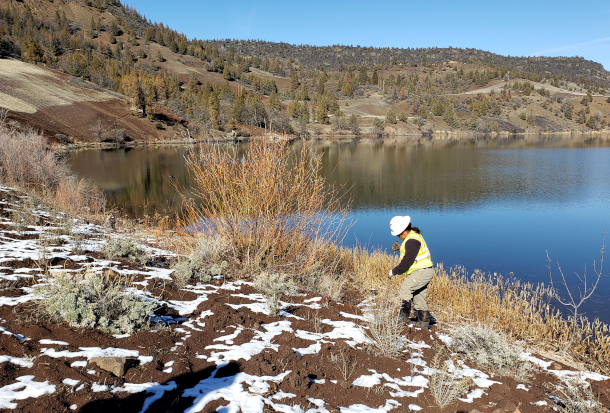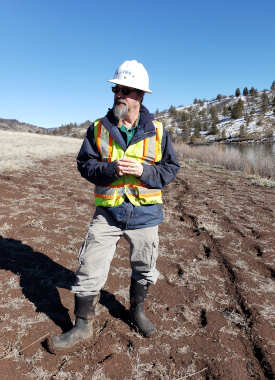Replanting The Klamath River
Air Date: Week of April 14, 2023

Yurok tribal member and Fish Technician 1 Frank Henry Jr. works alongside Iron Gate Reservoir in Feb. 2023. The reservoir will be drained when Iron Gate Dam is removed as part of the Klamath River restoration. (Photo: Juliet Grable / JPR)
Four dams are being torn down on the Klamath River, revealing land that’s been submerged for decades. Juliet Grable of Jefferson Public Radio reports that local tribes and partners are working to replant the area with native species.
Transcript
O’NEILL: The Klamath River meanders more than 250 miles along the California Oregon border. And right now, the river is the site of the largest dam removal project in US history. Four dams are being torn down with the goal to have them out completely by the end of 2024. The reservoirs behind the dams will be drained and the river will run free for the first time in a century. That means land that has been submerged all this time will suddenly be exposed. As Juliet Grable from Jefferson Public Radio reports, an effort is underway to replant the area with native species.
GRABLE: On the north shore of Iron Gate reservoir, Frank Henry Jr. jams a heavy metal pole into the ground and twists
[SFX]
HENRY: So I'm digging like maybe a 12, 13 inch hole with the rock bar.
GRABLE: He grabs a stick from a five gallon bucket and plants it in the hole. It's Klamath plum.
HENRY: These little ones that are kind of like cluttered together are the ones I'm putting in right now.
GRABLE: It will eventually grow into a shrubby tree that forms dense thickets. Henry is part of a crew contracted by resource environmental solutions or RES to restore the banks of the Klamath River after four dams come out. About 900 acres of wet mud will be exposed around Iron Gate reservoir, which is in Siskiyou County. Joshua Chenoweth is the Senior Riparian Ecologist for California's Yurok tribe. He's leading the dam replanting effort.

Joshua Chenoweth, senior riparian ecologist for the Yurok Tribe, is leading the replanting effort around Iron Gate Reservoir. (Photo: Juliet Grable / JPR)
CHENOWETH: It's our job to make sure it's revegetated and we want that to be revegetated with a healthy native plant ecosystem.
GRABLE: For the last two years Chenoweth's crew has been mowing a wide ribbon around the shoreline to keep out exotic invasive plants. Last fall, they seeded the strip with a mix of native species. Now they're installing young shrubs and trees, buckbrush and serviceberry along with the Klamath plum. Chenoweth is not a tribal member but nearly all his field technicians are either members of the Yurok tribe, like Henry, or the Karuk tribe.
CHENOWETH: Any revegetation project, if it's done right is adaptively managed by people that understand the landscape and there's no better place to look for that than the tribes and the people that live here and call home.
GRABLE: The revegetation of the Klamath River has been called the biggest river restoration project in American history. Collecting, propagating and growing enough seeds and plants to repopulate the reservoir footprints, approximately twenty-two hundred acres and all is a staggering task. Their planting design includes ninety-six different species, culturally significant plants like yampah and lomatium, important pollinator species like milkweed and tens of thousands of oak trees. Gwen Santos is the regulatory and ecology director for RES. She's been coordinating the revegetation effort.
SANTOS: We're up to 13 billion seeds, approximately, we're trying to get to 17 to 19 billion.
A field of Oregon sunshine being grown for the Klamath River restoration at BFI Native Seeds in Washington State. (Photo: Matt Benson / Resource Environmental Solutions)
GRABLE: There's no way to collect enough wild seeds to meet these targets. So RES has contracted with five commercial nurseries to propagate wild plants specifically for their seed, a process called seed amplification. Washington based BFI Native Seeds is one of the contracted nurseries. They have the challenging task of scaling up a small number of wild seeds into hundreds of pounds for this project. BFI's manager Matt Benson says, these native seeds haven't been bred as crops.
BENSON: We think very well, go plant the garden that does it and you don't realize oh, yeah, there's 6000 years of agriculture behind every seed I plant and I put in a garden or when a farmer plants a field, when we don't have any of that.
GRABLE: BFI is located near Moses Lake in Central Washington. Benson is growing 20 different native species, some of which have yielded surprises, like a field of mugwort, which started out as tiny tufts with gray green leaves.
BENSON: I mean, in one year, it shot up almost like corn does.
GRABLE: Benson had to keep raising his sprinklers to accommodate the plants, which eventually towered over 10 feet and produced huge masses of flowers. Joshua Chenoweth also helped lead the revegetation effort on what was previously the largest dam removal in the world. The removal of two dams on the Elwha River in Washington State. After the Yurok tribe toured the Elwha site, they recruited Chenoweth for the Klamath River Project. He says the pull to lead another project like this, on an even larger scale proved too hard to resist.
CHENOWETH: It was a whole new landscape to learn about and try to apply lessons learned to a new project and advance the science of revegetating reservoirs after a dam removal project.
GRABLE: But despite the monumental effort and dozens of species being cultivated, and he says, nature will still do most of the work.

Left: Elwha Dam removal work on October 20, 2011. Right: Former Elwha Dam site on May 1, 2012. (Photo: National Park Service)
CHENOWETH: We're trying to introduce as greater diversity as possible and then let the landscape teach us what's going to grow and work well.
GRABLE: RES will be actively planting the reservoirs for two years, then we'll maintain and monitor the sites for another five years. I'm Juliette Grable reporting.
O’NEILL: Juliet’s story comes to us courtesy of Jefferson Public Radio.
[MUSIC: Hot Club Sandwich, “Lily’s Bolero” on No Pressure, by Matt Sireely, self-published]
DOERING: On the next Living on Earth, Earth Day and a celebration of our only home.
PIERCE: Part of celebrating the Earth is finding a way to let ourselves experience the joy of this planet and all of its wonders, even as we’re aware of the crisis that it’s in.
DOERING: We’ll honor the earth with music, poetry and more next week on Living on Earth.
Links
Find the written version of this story on Oregon Public Broadcasting
From the Living on Earth archives: “Rafting Down the Unbound Elwha”
Living on Earth wants to hear from you!
Living on Earth
62 Calef Highway, Suite 212
Lee, NH 03861
Telephone: 617-287-4121
E-mail: comments@loe.org
Newsletter [Click here]
Donate to Living on Earth!
Living on Earth is an independent media program and relies entirely on contributions from listeners and institutions supporting public service. Please donate now to preserve an independent environmental voice.
NewsletterLiving on Earth offers a weekly delivery of the show's rundown to your mailbox. Sign up for our newsletter today!
 Sailors For The Sea: Be the change you want to sea.
Sailors For The Sea: Be the change you want to sea.
 The Grantham Foundation for the Protection of the Environment: Committed to protecting and improving the health of the global environment.
The Grantham Foundation for the Protection of the Environment: Committed to protecting and improving the health of the global environment.
 Contribute to Living on Earth and receive, as our gift to you, an archival print of one of Mark Seth Lender's extraordinary wildlife photographs. Follow the link to see Mark's current collection of photographs.
Contribute to Living on Earth and receive, as our gift to you, an archival print of one of Mark Seth Lender's extraordinary wildlife photographs. Follow the link to see Mark's current collection of photographs.
 Buy a signed copy of Mark Seth Lender's book Smeagull the Seagull & support Living on Earth
Buy a signed copy of Mark Seth Lender's book Smeagull the Seagull & support Living on Earth

